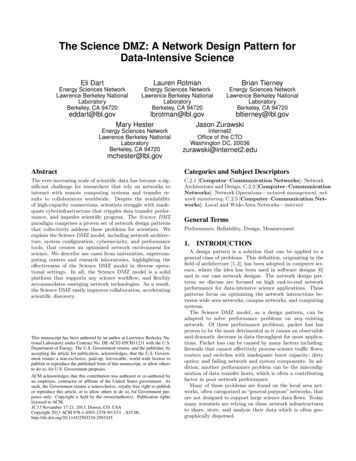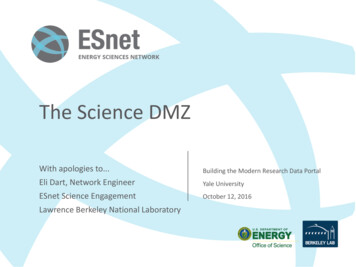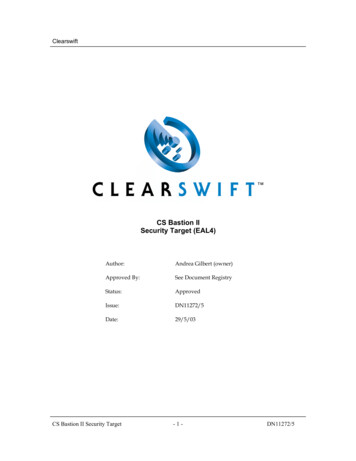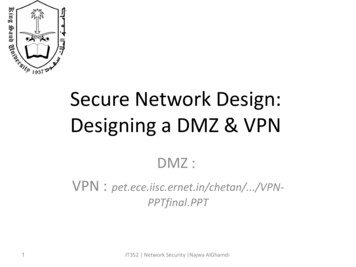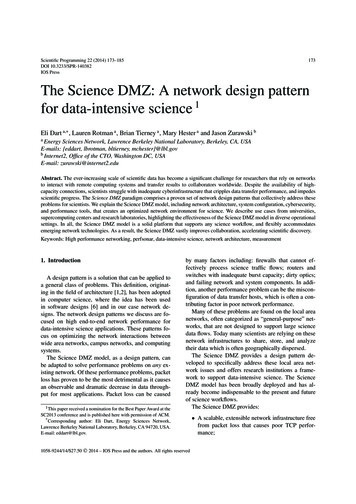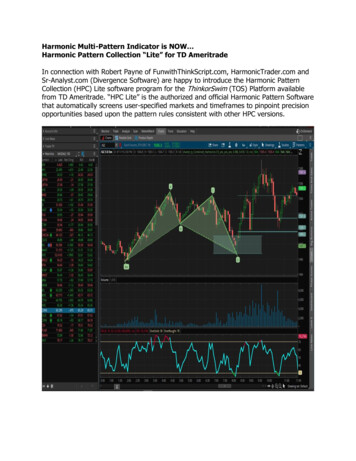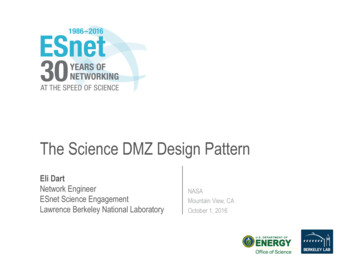
Transcription
The Science DMZ Design PatternEli DartNetwork EngineerESnet Science EngagementLawrence Berkeley National LaboratoryNASAMountain View, CAOctober 1, 2016
Overview Science DMZ Motivation and Introduction Science DMZ Architecture Network Monitoring For Performance Data Transfer Nodes & Applications Science DMZ Security Larger Context, Platform Science Engagement Pacific Research Platform Data Portal Discussion Petascale DTN Project2 – ESnet Science Engagement (engage@es.net) - 7/13/17 2016, Energy Sciences Network
Motivation Networks are an essential part of data-intensive science– Connect data sources to data analysis– Connect collaborators to each other– Enable machine-consumable interfaces to data and analysis resources (e.g. portals),automation, scale Performance is critical– Exponential data growth– Constant human factors– Data movement and data analysis must keep up Effective use of wide area (long-haul) networks by scientists hashistorically been difficult3 – ESnet Science Engagement (engage@es.net) - 7/13/17 2016, Energy Sciences Network
The Central Role of the Network The very structure of modern science assumes science networks exist: high performance,feature rich, global scope What is “The Network” anyway?– “The Network” is the set of devices and applications involved in the use of a remoteresource This is not about supercomputer interconnects This is about data flow from experiment to analysis, between facilities, etc.– User interfaces for “The Network” – portal, data transfer tool, workflow engine– Therefore, servers and applications must also be considered What is important? Ordered list:1.Correctness2.Consistency3.Performance4 – ESnet Science Engagement (engage@es.net) - 7/13/17 2016, Energy Sciences Network
TCP – Ubiquitous and Fragile Networks provide connectivity between hosts – how do hosts see the network?– From an application’s perspective, the interface to “the other end” is a socket– Communication is between applications – mostly over TCP TCP – the fragile workhorse– TCP is (for very good reasons) timid – packet loss is interpreted as congestion– Packet loss in conjunction with latency is a performance killer– Like it or not, TCP is used for the vast majority of data transfer applications (morethan 95% of ESnet traffic is TCP)5 – ESnet Science Engagement (engage@es.net) - 7/13/17 2016, Energy Sciences Network
.
Working With TCP In Practice Far easier to support TCP than to fix TCP– People have been trying to fix TCP for years – limited success– Like it or not we’re stuck with TCP in the general case Pragmatically speaking, we must accommodate TCP– Sufficient bandwidth to avoid congestion– Zero packet loss– Verifiable infrastructure Networks are complex Must be able to locate problems quickly Small footprint is a huge win – small number of devices so that problem isolation istractable7 – ESnet Science Engagement (engage@es.net) - 7/13/17 2016, Energy Sciences Network
Putting A Solution Together Effective support for TCP-based data transfer– Design for correct, consistent, high-performance operation– Design for ease of troubleshooting Easy adoption is critical– Large laboratories and universities have extensive IT deployments– Drastic change is prohibitively difficult Cybersecurity – defensible without compromising performance Borrow ideas from traditional network security– Traditional DMZ Separate enclave at network perimeter (“Demilitarized Zone”) Specific location for external-facing services Clean separation from internal network– Do the same thing for science – Science DMZ8 – ESnet Science Engagement (engage@es.net) - 7/13/17 2016, Energy Sciences Network
The Science DMZ Design PatternDedicatedSystems for DataTransferNetwork Science DMZ Performance perfSONARArchitecture Dedicated network Testing & Enables fault isolationHigh performancefor high-speed Verify correct operationConfigured specificallyMeasurementdate resources Widely deployed in ESnetData Transfer Node for data transferProper tools9 – ESnet Science Engagement (engage@es.net) - 7/13/17 Appropriate securityEasy to deploy - no need toredesign the whole networkand other networks, as wellas sites and facilities 2016, Energy Sciences Network
Abstract or Prototype Deployment Add-on to existing network infrastructure– All that is required is a port on the border router– Small footprint, pre-production commitment Easy to experiment with components and technologies– DTN prototyping– perfSONAR testing Limited scope makes security policy exceptions easy– Only allow traffic from partners– Add-on to production infrastructure – lower risk10 – ESnet Science Engagement (engage@es.net) - 7/13/17 2016, Energy Sciences Network
Science DMZ Design Pattern (Abstract)Border RouterWANEnterprise BorderRouter/Firewall10GClean,High-bandwidthWAN pathSite / Campusaccess to ScienceDMZ resourcesperfSONARSite / CampusLANScience DMZSwitch/RouterPer-servicesecurity policycontrol pointsHigh performanceData Transfer Nodewith high-speed storage11 – ESnet Science Engagement (engage@es.net) - 7/13/17 2016, Energy Sciences Network
Local And Wide Area Data FlowsBorder RouterperfSONARWAN10GEnterprise BorderRouter/Firewall10GE10GESite / Campusaccess to ScienceDMZ resourcesClean,High-bandwidthWAN pathperfSONAR10GESite / CampusLANScience DMZSwitch/Router10GEperfSONARPer-servicesecurity policycontrol pointsHigh performanceData Transfer Nodewith high-speed storage12 – ESnet Science Engagement (engage@es.net) - 7/13/17High Latency WAN PathLow Latency LAN Path 2016, Energy Sciences Network
Support For Multiple Projects Science DMZ architecture allows multiple projects to put DTNs in place– Modular architecture– Centralized location for data servers This may or may not work well depending on institutional policies– Sometimes individual groups deploy their own servers, and centralization is hard– Sometimes centralization is a strategic goal On balance, this can provide a cost savings – it depends– Central support for data servers vs. carrying data flows– How far do the data flows have to go? Dark fiber asses can be a huge win13 – ESnet Science Engagement (engage@es.net) - 7/13/17 2016, Energy Sciences Network
Multiple ProjectsBorder RouterEnterprise BorderRouter/FirewallWAN10G10GE10GESite / Campusaccess to ScienceDMZ resourcesClean,High-bandwidthWAN pathperfSONAR10GESite / CampusLANScience DMZSwitch/RouterperfSONARProject A DTNPer-projectsecurity policycontrol pointsProject B DTNProject C DTN14 – ESnet Science Engagement (engage@es.net) - 7/13/17 2016, Energy Sciences Network
Multiple Science DMZs – Dark FiberBorder RouterEnterprise NARDarkFiberDarkFiberSite / CampusLANScience ritypolicyperfSONARCluster(building C)Project A DTN(building A)Facility B DTN(building B)15 – ESnet Science Engagement (engage@es.net) - 7/13/17Cluster DTN(building C) 2016, Energy Sciences Network
Supercomputer Center Deployment High-performance networking is assumed in this environment– Data flows between systems, between systems and storage, wide area, etc.– Global filesystem often ties resources together Portions of this may not run over Ethernet (e.g. IB) Implications for Data Transfer Nodes “Science DMZ” may not look like a discrete entity here– By the time you get through interconnecting all the resources, you end up with most of thenetwork in the Science DMZ– This is as it should be – the point is appropriate deployment of tools, configuration, policycontrol, etc. Office networks can look like an afterthought, but they aren’t– Deployed with appropriate security controls– Office infrastructure need not be sized for science traffic16 – ESnet Science Engagement (engage@es.net) - 7/13/17 2016, Energy Sciences Network
Supercomputer CenterBorder uitperfSONARCoreSwitch/RouterFront endswitchFront endswitchperfSONARData TransferNodesSupercomputerParallel Filesystem17 – ESnet Science Engagement (engage@es.net) - 7/13/17 2016, Energy Sciences Network
Supercomputer Center Data PathBorder uitperfSONARCoreSwitch/RouterFront endswitchFront endswitchperfSONARData TransferNodesHigh Latency WAN PathSupercomputerLow Latency LAN PathParallel Filesystem18 – ESnet Science Engagement (engage@es.net) - 7/13/17High Latency VC Path 2016, Energy Sciences Network
Major Data Site Deployment In some cases, large scale data service is the major driver– Huge volumes of data (Petabytes or more) – ingest, export– Large number of external hosts accessing/submitting data Single-pipe deployments don’t work– Everything is parallel Networks (Nx10G LAGs, soon to be Nx100G) Hosts – data transfer clusters, no individual DTNs WAN connections – multiple entry, redundant equipment– Choke points (e.g. firewalls) just cause problems19 – ESnet Science Engagement (engage@es.net) - 7/13/17 2016, Energy Sciences Network
Data Site – ArchitectureVirtualCircuitVCProvider EdgeRoutersWANVirtualCircuitperfSONARData Site/CampusLANData ServiceSwitch PlaneperfSONAR20 – ESnet Science Engagement (engage@es.net) - 7/13/17 2016, Energy Sciences Network
Data Site – Data PathVirtualCircuitVCProvider EdgeRoutersWANVirtualCircuitperfSONARData Site/CampusLANData ServiceSwitch PlaneperfSONAR21 – ESnet Science Engagement (engage@es.net) - 7/13/17 2016, Energy Sciences Network
Common Threads Two common threads exist in all these examples Accommodation of TCP– Wide area portion of data transfers traverses purpose-built path– High performance devices that don’t drop packets Ability to test and verify– When problems arise (and they always will), they can be solved if the infrastructure is builtcorrectly– Small device count makes it easier to find issues– Multiple test and measurement hosts provide multiple views of the data path perfSONAR nodes at the site and in the WAN perfSONAR nodes at the remote site22 – ESnet Science Engagement (engage@es.net) - 7/13/17 2016, Energy Sciences Network
Performance Monitoring Everything may function perfectly when it is deployed Eventually something is going to break– Networks and systems are complex– Bugs, mistakes, – Sometimes things just break – this is why we buy support contracts Must be able to find and fix problems when they occur Must be able to find problems in other networks (your network may be fine, butsomeone else’s problem can impact your users) TCP was intentionally designed to hide all transmission errors from the user:– “As long as the TCPs continue to function properly and the internet system doesnot become completely partitioned, no transmission errors will affect the users.”(From RFC793, 1981)23 – ESnet Science Engagement (engage@es.net) - 7/13/17 2016, Energy Sciences Network
Testing Infrastructure – perfSONAR perfSONAR is:– A widely-deployed test and measurement infrastructure ESnet, Internet2, US regional networks, international networks Laboratories, supercomputer centers, universities Individual Linux hosts at key network locations (POPs, Science DMZs, etc.)– A suite of test and measurement tools– A collaboration that builds and maintains the toolkit By installing perfSONAR, a site can leverage over 2000 test servers deployed around the world perfSONAR is ideal for finding soft failures– Alert to existence of problems– Fault isolation– Verification of correct operation24 – ESnet Science Engagement (engage@es.net) - 7/13/17 2016, Energy Sciences Network
Dedicated Systems – The Data Transfer Node The DTN is dedicated to data transfer Set up specifically for high-performance data movement– System internals (BIOS, firmware, interrupts, etc.)– Network stack– Storage (global filesystem, Fibrechannel, local RAID, etc.)– High performance tools– No extraneous software Limitation of scope and function is powerful– No conflicts with configuration for other tasks– Small application set makes cybersecurity easier Limitation of application set is often a core security policy component25 – ESnet Science Engagement (engage@es.net) - 7/13/17 2016, Energy Sciences Network
Science DMZ Security Goal – disentangle security policy and enforcement for science flowsfrom security for business systems Rationale– Science data traffic is simple from a security perspective– Narrow application set on Science DMZ Data transfer, data streaming packages No printers, document readers, web browsers, building control systems, financialdatabases, staff desktops, etc.– Security controls that are typically implemented to protect business resources often causeperformance problems Separation allows each to be optimized26 – ESnet Science Engagement (engage@es.net) - 7/13/17 2016, Energy Sciences Network
Science DMZ As Security Architecture Allows for better segmentation of risks, more granular application of controls tothose segmented risks.– Limit risk profile for high-performance data transfer applications– Apply specific controls to data transfer hosts– Avoid including unnecessary risks, unnecessary controls Remove degrees of freedom – focus only on what is necessary– Easier to secure– Easier to achieve performance– Easier to troubleshoot27 – ESnet Science Engagement (engage@es.net) - 7/13/17 2016, Energy Sciences Network
Performance Is A Core Requirement Core information security principles– Confidentiality, Integrity, Availability (CIA)– Often, CIA and risk mitigation result in poor performance In data-intensive science, performance is an additional core missionrequirement: CIA à PICA– CIA principles are important, but if performance is compromised the sciencemission fails– Not about “how much” security you have, but how the security is implemented– Need a way to appropriately secure systems without performance compromises28 – ESnet Science Engagement (engage@es.net) - 7/13/17 2016, Energy Sciences Network
Placement Outside the Firewall The Science DMZ resources are placed outside the enterprise firewallfor performance reasons– The meaning of this is specific – Science DMZ traffic does not traverse thefirewall data plane– Packet filtering is fine – just don’t do it with a firewall Lots of heartburn over this, especially from the perspective of aconventional firewall manager– Lots of organizational policy directives mandating firewalls– Firewalls are designed to protect converged enterprise networks– Why would you put critical assets outside the firewall? The answer is that firewalls are typically a poor fit for high-performancescience applications29 – ESnet Science Engagement (engage@es.net) - 7/13/17 2016, Energy Sciences Network
Security Without Firewalls Data intensive science traffic interacts poorly with firewalls Does this mean we ignore security? NO!– We must protect our systems– We just need to find a way to do security that does not prevent usfrom getting the science done Key point – security policies and mechanisms that protect theScience DMZ should be implemented so that they do notcompromise performance Traffic permitted by policy should not experience performance impact asa result of the application of policy30 – ESnet Science Engagement (engage@es.net) - 7/13/17 2016, Energy Sciences Network
The Data Transfer Superfecta: Science DMZ ModelEngagement Resources & KnowledgebasePartnershipsEducation & ConsultingperfSONAR Enables fault isolationVerify correct operationWidely deployed in ESnetand other networks, as wellas sites and facilitiesData Transfer Node Configured for data transferHigh performanceProper toolsScience DMZ 31 – ESnet Science Engagement (engage@es.net) - 7/13/17Dedicated location for DTNProper securityEasy to deploy - no need to redesign the wholenetwork 2016, Energy Sciences Network
Context Setting DOE, NSF, and other agencies are investingbillions of dollars in state-of-the-artcyberinfrastructure to support data-intensivescience. Many researchers do not understand thevalue of these services and have difficultyusing them. A proactive effort is needed to drive adoptionof advanced services and accelerate scienceoutput: Science Engagement32 – ESnet Science Engagement (engage@es.net) - 7/13/17 2016, Energy Sciences Network
ESnet Science Engagement Team VisionCollaborations at every scale, in every domain, will have theinformation and tools they need to achieve maximumbenefit from global networks through the creation ofscalable, community-driven strategies and approaches.ESnet vision: Scientific progress is completelyunconstrained by the physical location of instruments,people, computational resources, or data.
Science Engagement Science Engagement team works in several areas at once– Understand key elements which contribute to desired outcomes Requirements analysis – what is needed Also identify choke points, road blocks, missing components– Network architecture, performance, best practice– Systems engineering, consulting, troubleshooting– Collaboration with others– Workshops and webinars Important bridge between cyberinfrastructure and scientists34 – ESnet Science Engagement (engage@es.net) - 7/13/17 2016, Energy Sciences Network
Science DMZ Wrapup The Science DMZ design pattern provides a flexible model for supporting high-performancedata transfers and workflows Key elements:– Accommodation of TCP Sufficient bandwidth to avoid congestion Loss-free IP service– Location – near the site perimeter if possible– Test and measurement– Dedicated systems– Appropriate security– Science Engagement to foster adoption35 – ESnet Science Engagement (engage@es.net) - 7/13/17 2016, Energy Sciences Network
Overview Science DMZ Motivation and Introduction Science DMZ Architecture Network Monitoring For Performance Data Transfer Nodes & Applications Science DMZ Security Science Engagement Larger Context, Platform Pacific Research Platform Data Portal Discussion Petascale DTN Project36 – ESnet Science Engagement (engage@es.net) - 7/13/17 2016, Energy Sciences Network
Context: Science DMZ Adoption DOE National Laboratories– HPC centers, LHC sites, experimental facilities– Both large and small sites NSF CC* programs have funded many Science DMZs– Significant investments across the US university complex– Big shoutout to the NSF – these programs are critically important Other US agencies– NIH– USDA Agricultural Research Service International– Australia https://www.rdsi.edu.au/dashnet– Brazil– UK37 – ESnet Science Engagement (engage@es.net) - 7/13/17 2016, Energy Sciences Network
Strategic Impacts What does this mean?– We are in the midst of a significant cyberinfrastructure upgrade– Enterprise networks need not be unduly perturbed J Significantly enhanced capabilities compared to 3 years ago– Terabyte-scale data movement is much easier– Petabyte-scale data movement possible outside the LHC experiments 3.1Gbps 1PB/month 14Gbps 1PB/week– Widely-deployed tools are much better (e.g. Globus) Metcalfe’s Law of Network Utility– Value of Science DMZ proportional to the number of DMZs n2 or n(logn) doesn’t matter – the effect is real– Cyberinfrastructure value increases as we all upgrade38 – ESnet Science Engagement (engage@es.net) - 7/13/17 2016, Energy Sciences Network
Next Steps – Building On The Science DMZ Enhanced cyberinfrastructure substrate now exists– Wide area networks (ESnet, GEANT, Internet2, Regionals)– Science DMZs connected to those networks– DTNs in the Science DMZs What does the scientist see?– Scientist sees a science application Data transfer Data portal Data analysis– Science applications are the user interface to networks and DMZs The underlying cyberinfrastructure components (networks, Science DMZs, DTNs, etc.)are part of the instrument of discovery Large-scale data-intensive science requires that we build larger structures on top of thosecomponents39 – ESnet Science Engagement (engage@es.net) - 7/13/17 2016, Energy Sciences Network
The Pacific Research Platform Creates a Regional End-to-EndScience-Driven “Big Data Freeway System”NSF CC*DNI Grant 5M 10/2015-10/2020 PI: Larry Smarr, UC San DiegoCalit2 Co-PIs:- Camille Crittenden, UC BerkeleyCITRIS,- Tom DeFanti, UC San DiegoCalit2,- Philip Papadopoulos, UC SanDiego SDSC,- Frank Wuerthwein, UC SanDiego Physics and SDSC40
Science Data Portals Large repositories of scientific data– Climate data– Sky surveys (astronomy, cosmology)– Many others– Data search, browsing, access Many scientific data portals were designed 15 years ago– Single-web-server design– Data browse/search, data access, user awareness all in a single system– All the data goes through the portal server In many cases by design E.g. embargo before publication (enforce access control)41 – ESnet Science Engagement (engage@es.net) - 7/13/17 2016, Energy Sciences Network
Legacy Portal DesignBorder RouterperfSONARFirewallWANperfSONAR Very difficult to improve performance withoutarchitectural change– Software components all tangled together– Difficult to put the whole portal in a ScienceDMZ because of security– Even if you could put it in a DMZ, manycomponents aren’t scalableEnterpriseBrowsing pathQuery pathData path10GEPortal server applications:· web server· search· database· authentication· data servicePortalServer10GEFilesystem(data store) What does architectural change mean?42 – ESnet Science Engagement (engage@es.net) - 7/13/17 2016, Energy Sciences Network
Next-Generation Portal Leverages Science DMZperfSONARBorder RouterFirewallWANEnterpriseData PathBrowsing pathQuery path10GEperfSONARperfSONARPortal server applications:· web server· search· database· authenticationScience DMZSwitch/RouterPortalServer10GE10GEData Transfer Path10GE10GE10GE10GEDTN10GEPortal Query/Browse PathDTNDTN43 – ESnet Science Engagement (engage@es.net) - 7/13/17DTNFilesystem(data store)10GEAPI DTNs(data access governedby portal) 2016, Energy Sciences Network
Put The Data On Dedicated Infrastructure We have separated the data handling from the portal logic Portal is still its normal self, but enhanced– Portal GUI, database, search, etc. all function as they did before– Query returns pointers to data objects in the Science DMZ– Portal is now freed from ties to the data servers (run it on Amazon if you want!) Data handling is separate, and scalable– High-performance DTNs in the Science DMZ– Scale as much as you need to without modifying the portal software Outsource data handling to computing centers or campus central storage– Computing centers are set up for large-scale data– Let them handle the large-scale data, and let the portal do the orchestration of dataplacement44 – ESnet Science Engagement (engage@es.net) - 7/13/17 2016, Energy Sciences Network
Ecosystem Is Ready For This Science DMZs are deployed at Labs, Universities, and computing centers– XSEDE sites– DOE HPC facilities– Many campus clusters Globus DTNs are present in many of those Science DMZs– XSEDE sites– DOE HPC facilities– Many campus clusters Architectural change allows data placement at scale– Submit a query to the portal, Globus places the data at an HPC facility– Run the analysis at the HPC facility– The results are the only thing that ends up on a laptop or workstation45 – ESnet Science Engagement (engage@es.net) - 7/13/17 2016, Energy Sciences Network
Petascale DTN Project Another example of building on the Science DMZ Supports all data-intensive applications which require large-scale data placement Collaboration between HPC facilities– ALCF, NCSA, NERSC, OLCF Goal: per-Globus-job performance at 1PB/week level– 15 gigabits per second– With checksums turned on, etc.– No special shortcuts, no arcane options Reference data set is 4.4TB of astrophysics model output– Mix of file sizes– Many directories– Real data!46 – ESnet Science Engagement (engage@es.net) - 7/13/17 2016, Energy Sciences Network
Petascale DTN Projectalcf#dtn miraALCFMay 2016DTN5.4 Gbps6.0 Gbpsnersc#dtnNERSC17.3 Gbps12.1 Gbps4.1 Gbps5.5 GbpsDTN10.1 GbpsDTNolcf#dtn atlasOLCF12.0 Gbps5.5 Gbps18.3 Gbps5.5 GbpsDTNncsa#BlueWatersNCSA47 – ESnet Science Engagement (engage@es.net) - 7/13/179.0 GbpsData set: L380Files: 19260Directories: 211Other files: 0Total bytes: 4442781786482 (4.4T bytes)Smallest file: 0 bytes (0 bytes)Largest file: 11313896248 bytes (11G bytes)Size distribution:1 - 10 bytes: 7 files10 - 100 bytes: 1 files100 - 1K bytes: 59 files1K - 10K bytes: 3170 files10K - 100K bytes: 1560 files100K - 1M bytes: 2817 files1M - 10M bytes: 3901 files10M - 100M bytes: 3800 files100M - 1G bytes: 2295 files1G - 10G bytes: 1647 files10G - 100G bytes: 3 files 2016, Energy Sciences Network
Links and Lists– ESnet fasterdata knowledge base–––– http://fasterdata.es.net/Science DMZ paper http://www.es.net/assets/pubs presos/sc13sciDMZ-final.pdfScience DMZ email list Send mail to sympa@lists.lbl.gov with subject "subscribe esnet-sciencedmz”perfSONAR onar/ http://www.perfsonar.netGlobus https://www.globus.org/48 – ESnet Science Engagement (engage@es.net) - 7/13/17 2016, Energy Sciences Network
Thanks!Eli Dartdart@es.netEnergy Sciences Network (ESnet)Lawrence Berkeley National //fasterdata.es.net/
Extra Slides507/13/17
Science DMZ Security Goal – disentangle security policy and enforcement for science flowsfrom security for business systems Rationale– Science data traffic is simple from a security perspective– Narrow application set on Science DMZ Data transfer, data streaming packages No printers, document readers, web browsers, building control systems, financialdatabases, staff desktops, etc.– Security controls that are typically implemented to protect business resources often causeperformance problems Separation allows each to be optimized51 – ESnet Science Engagement (engage@es.net) - 7/13/17 2015, Energy Sciences Network
Science DMZ As Security Architecture Allows for better segmentation of risks, more granular application of controls tothose segmented risks.– Limit risk profile for high-performance data transfer applications– Apply specific controls to data transfer hosts– Avoid including unnecessary risks, unnecessary controls Remove degrees of freedom – focus only on what is necessary– Easier to secure– Easier to achieve performance– Easier to troubleshoot52 – ESnet Science Engagement (engage@es.net) - 7/13/17 2016, Energy Sciences Network
Performance Is A Core Requirement Core information security principles– Confidentiality, Integrity, Availability (CIA)– Often, CIA and risk mitigation result in poor performance In data-intensive science, performance is an additional core missionrequirement: CIA à PICA– CIA principles are important, but if performance is compromised the science missionfails– Not about “how much” security you have, but how the security is implemented– Need a way to appropriately secure systems without performance compromises53 – ESnet Science Engagement (engage@es.net) - 7/13/17 2015, Energy Sciences Network
Placement Outside the Firewall The Science DMZ resources are placed outside the enterprise firewallfor performance reasons– The meaning of this is specific – Science DMZ traffic does not traverse thefirewall data plane– Packet filtering is great – just don’t do it with an enterprise firewall Lots of heartburn over this, especially from the perspective of aconventional firewall manager– Lots of organizational policy directives mandating firewalls– Firewalls are designed to protect converged enterprise networks– Why would you put critical assets outside the firewall? The answer is that enterprise firewalls are typically a poor fit for highperformance science applications54 – ESnet Science Engagement (engage@es.net) - 7/13/17 2015, Energy Sciences Network
Typical Firewall Internals Typical firewalls are composed of a set of processors which inspecttraffic in parallel– Traffic distributed among processors such that all traffic for a particular connectiongoes to the same processor– Simplifies state management– Parallelization scales deep analysis Excellent fit for enterprise traffic profile– High connection count, low per-connection data rate– Complex protocols with embedded threats Each processor is a fraction of firewall link speed– Significant limitation for data-intensive science applications– Overload causes packet loss – performance crashes55 – ESnet Science Engagement (engage@es.net) - 7/13/17 2015, Energy Sciences Network
Thought Experiment We’re going to do a thought experiment Consider a network between three buildings – A, B, and C This is supposedly a 10Gbps network end to end (look at the links on the buildings) Building A houses the border router – not much goes on there except the external connectivity Lots of work happens in building B – so much that the processing is done with multipleprocessors to spread the load in an affordable way, and results are aggregated after Building C is where we branch out to other buildings Every link between buildings is 10Gbps – this is a 10Gbps network, right?56 – ESnet Science Engagement (engage@es.net) - 7/13/17 2015, Energy Sciences Network
Notional 10G Network Between BuildingsBuilding BWAN10GE10GE1G1G1G1G1GperfSONAR1GBuilding LayoutTo Other Buildings1G1GBuilding A1G 1G 1G1G1G1G1G1G1G 1G 1G1GBuilding C10GE10GE10GE10GE57 – ESnet Science Engagement (engage@es.net) - 7/13/17 2015, Energy Sciences Network
Clearly Not A 10Gbps Network If you look at the inside of Building B, it is obvious from a network engineering perspective thatthis is not a 1
Borrow ideas from traditional network security - Traditional DMZ Separate enclave at network perimeter ("Demilitarized Zone") Specific location for external-facing services Clean separation from internal network - Do the same thing for science - Science DMZ


